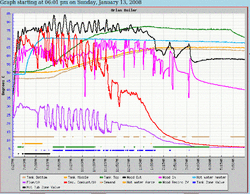heaterman
Minister of Fire
Raw Combustion efficiency vs system efficiency
Combustion efficiency is relatively easy to measure if you have the tool I.E., a combustion analyzer.
System efficiency, which is what nofossil is trying to measure is a completely different animal and orders of magnitude harder to calculate. There are a host of areas that present parasitic losses on a system, some of which are mentioned in the posts above.
Trying to calculate system efficiency would involve starting with your combustion numbers and then measuring heat transfer throughout the entire system. This is virtually impossible to do because the whole time you are measuring heat output into your structure in order to compute temp rise, the structure is at the same time losing heat into the great outdoors. So how do you actually know the amount of heat you put into the structure? (This factor alone may be what is skewing your numbers so low.)
Tough tough tough to do. You're talking lab grade equipment to do the measurements with and a Cray to crunch the numbers.
One could roughly estimate what's going on if you have a good handle on your flow rate and temp drop from supply to return. This will give you an approximation of the total heat transfered outside the boiler. Then you'd have to factor in the jacket losses of the boiler, the cubic feet and net temp rise of your flue gas going up the stack. Actual btu content of the fuel being burned is obviously a matter of differing opinion...............but you'd have to start there to determine actual input. Without that as your starting number you're just "blowing smoke". (feeble attempt at joke there) AHHHHHHHHHHHHHHHHHHH !! my head is starting to spin just thinking about it.
!! my head is starting to spin just thinking about it.
I went to a training class on Riello burners last year and while there talked to a couple of their lab guys doing an AFUE rating test on a boiler with their burner installed on it. They spent the better part of 4 hours just dialing in the flow rate to get the 20* drop called for in AFUE testing protocol. AFUE specs call for testing at 140 supply and 120 return. (Not reflective of 99% of the boiler systems actually out there but hey.....it's a government spec so what did you expect.....) At that point you can begin to measure what the actual output of the boiler is. Next they hooked up their gear to precisely measure fuel input (this one was oil) which was measured to the milligram.........you get my drift........ Then there were flue gas measurements which were factored in to the equation. And on and on and on and this is just measuring boiler/burner efficiency. All I can say is in less than lab conditions, I don't know how you would get anything close to valid.
Gotta say it is fun exercising the ol noggin thinking about it.
Combustion efficiency is relatively easy to measure if you have the tool I.E., a combustion analyzer.
System efficiency, which is what nofossil is trying to measure is a completely different animal and orders of magnitude harder to calculate. There are a host of areas that present parasitic losses on a system, some of which are mentioned in the posts above.
Trying to calculate system efficiency would involve starting with your combustion numbers and then measuring heat transfer throughout the entire system. This is virtually impossible to do because the whole time you are measuring heat output into your structure in order to compute temp rise, the structure is at the same time losing heat into the great outdoors. So how do you actually know the amount of heat you put into the structure? (This factor alone may be what is skewing your numbers so low.)
Tough tough tough to do. You're talking lab grade equipment to do the measurements with and a Cray to crunch the numbers.
One could roughly estimate what's going on if you have a good handle on your flow rate and temp drop from supply to return. This will give you an approximation of the total heat transfered outside the boiler. Then you'd have to factor in the jacket losses of the boiler, the cubic feet and net temp rise of your flue gas going up the stack. Actual btu content of the fuel being burned is obviously a matter of differing opinion...............but you'd have to start there to determine actual input. Without that as your starting number you're just "blowing smoke". (feeble attempt at joke there) AHHHHHHHHHHHHHHHHHHH
 !! my head is starting to spin just thinking about it.
!! my head is starting to spin just thinking about it. I went to a training class on Riello burners last year and while there talked to a couple of their lab guys doing an AFUE rating test on a boiler with their burner installed on it. They spent the better part of 4 hours just dialing in the flow rate to get the 20* drop called for in AFUE testing protocol. AFUE specs call for testing at 140 supply and 120 return. (Not reflective of 99% of the boiler systems actually out there but hey.....it's a government spec so what did you expect.....) At that point you can begin to measure what the actual output of the boiler is. Next they hooked up their gear to precisely measure fuel input (this one was oil) which was measured to the milligram.........you get my drift........ Then there were flue gas measurements which were factored in to the equation. And on and on and on and this is just measuring boiler/burner efficiency. All I can say is in less than lab conditions, I don't know how you would get anything close to valid.
Gotta say it is fun exercising the ol noggin thinking about it.


